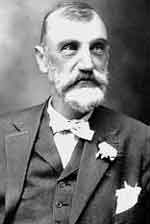This excerpt is abridged from Why Didn’t Somebody Tell Somebody?, a pamphlet published by Los Angeles newspaperman Charles Harris (Brick) Garrigues in May 1938 and republished in January 1939.
A curious blending of the romanticist and the realist was old Abbot Kinney. In his youth he had travelled Europe, the Levant, and Asia Minor, buying tobacco from Greece and Turkey, shipping whole shiploads of it to England or America and selling it again the the tobacconists of the Old or New World.
In the Graeco-Turkish war, he got the break for which he had been waiting. Coming from Greece with a shipload of perique — a strong, harsh tobacco, essential for blending but grown only in the East — he learned of the outbreak of the war and learned, too, that his ship would be the last tobacco ship to leave the Mediterranean. When he arrived in London, he found that the news of the war had not yet reached the tobacconists of England.
For three days he hurried from warehouse to warehouse, buying every pound of perique tobacco in the British Isles. On the fourth day the news of the war broke out and Kinney had cornered the perique supply of the world. Without him, no man in England or America could smoke his favorite brand — and Kinney sold back his perique at a price which made him a multimillionaire.
So much for Abbot Kinney, the realist. Abbot Kinney, the romanticist, came back to America and determined to found, on the shores of the Pacific, a town which should be peculiarly his own and which should include all of the best that the had found in the Old World.

Here — with a sweep of his hand — a bit of Venice, Italy. Here — with a crooking of his finger — a bit of Ostend. Here, with curious disregard of the Comstockian America that was to come, a bit of a red-light district modeled after a street in Naples.
A central steam plant which was to provide not only steam, but also hot salt water to every room and apartment in the city. A pier for pleasure, the baths, and beyond all, the widest, safest beach on the coast, where the people could come in the trains of the day or in carriages — or lumber wagons — to spend a few hours in the shockingly brief bathing costumes of the 1920s. Romantic, glamourous, a city for pleasure, but in those days nothing cheap, nothing tawdry.
There was a curious flavor to the Venice of those days — an intense local patriotism which had nothing to do with chambers of commerce and the price of real estate.
Soft lights on the lagoon, soft Italian music, gondolas drifting by night through limpid canals. The children used to sing to the tune of “The Good Old Summer Time”:
Venice, Venice, that is the place for me
That is the place for the human race
Down by the sea —
And they used to hate Long Beach, which was also trying to be a beach city in a commercialized fashion.
If you knew Avalon on Catalina Island in the days before the crowds came, when the band closed every concert with the song that Al Jolson made famous while the crowd stood with bared heads as though listening to a national anthem, if you knew the Laguna of twelve years ago, you know how it was in Venice in those old days.
There were three things that Abbot Kinney did not know. One was that the twentieth century was here. One was that you couldn’t transplant a culture and have it grow. One was that the pier which he had built was causing the sand to be gouged from the shore and dragged into the abyss at Redondo.
The twentieth century brought many things for which the old man had not prepared. Chief among them was the automobiles. In all of Venice there was not a single street worthy of the name. From south to north a narrow alley, barely twenty feet wide. From east to west, narrow alleys, blind at both ends. Promenades to walk on, trains to ride on — but no streets.
The culture of the Old World never quite took root. When Prohibition came there was little left of Venice except plaster dolls in sideshow concessions, and when Prohibition left, it left behind it not a trace of what Abbot Kinney — then dead — had planned.